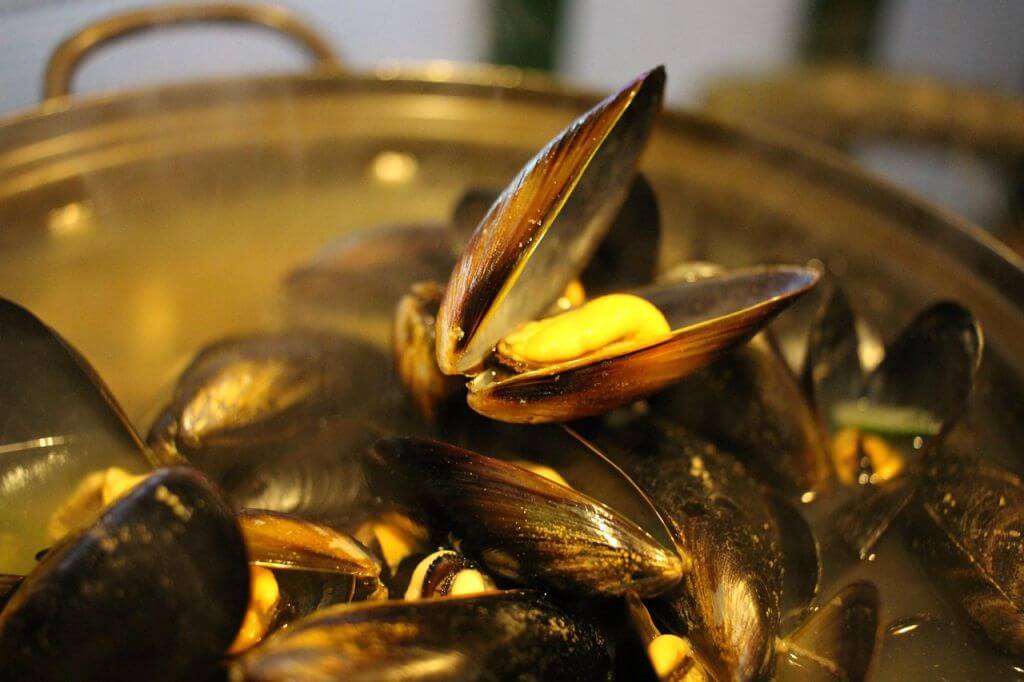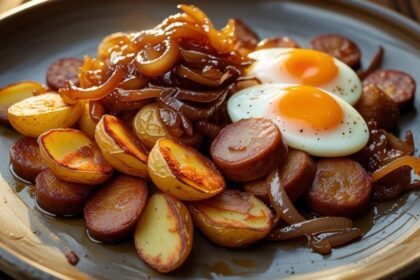Briny, sweet mussels steamed in a fragrant beer broth with garlic, butter, and fresh herbs. The beer adds malty depth and a gentle bitterness that balances the ocean flavor and makes an irresistible dipping sauce for crusty bread.
Serves
4 as an appetizer, 2 as a main
Prep Time
15 minutes (cleaning mussels)
Cook Time
10–12 minutes
Ingredients
Mussels and Aromatics
- 2 lb fresh mussels, scrubbed and debearded
- 2 tbsp unsalted butter
- 1 tbsp olive oil
- 4–5 garlic cloves, thinly sliced or minced
- 1 medium shallot, finely chopped (or 1/2 small onion)
- 1/4 tsp red pepper flakes (optional, for gentle heat)
- 1 tsp lemon zest (optional, bright finish)
Beer Broth
- 1 cup beer (lager, pilsner, Kölsch, or light pale ale)
- 1/2 cup low-sodium seafood or chicken stock (or water)
- 1 tbsp Dijon mustard (helps emulsify and adds depth)
- 1–2 tsp lemon juice, plus more to taste
- 2–3 sprigs fresh thyme (or 1/2 tsp dried)
- 1 small bay leaf
Finish
- 2 tbsp unsalted butter (cold, for mounting the sauce)
- 1/4 cup chopped fresh parsley (and/or chives, dill)
- Freshly ground black pepper
- Crusty bread, fries, or cooked pasta for serving
- Lemon wedges

Why Beer Works
Beer brings gentle malt sweetness, toasted grain notes, and a hint of bitterness that complements the mussels’ natural brine. As it steams, the beer perfumes the shellfish and reduces into a savory broth with body. Lagers and pilsners keep flavors clean and bright; a light pale ale adds a subtle hop snap. Avoid very bitter IPAs or dark stouts, which can turn harsh.
Instructions
- Clean and check mussels
- Rinse mussels under cold water, scrubbing shells. Pull off any beards (fibrous threads) by tugging toward the hinge.
- Discard any mussels with cracked shells or those that stay open after a firm tap.
- Sauté aromatics
- In a large, wide pot or Dutch oven, heat 2 tbsp butter and olive oil over medium heat.
- Add shallot and a pinch of salt; cook 2–3 minutes until translucent.
- Stir in garlic and red pepper flakes; cook 30–45 seconds until fragrant (don’t brown).
- Build the beer broth
- Add beer, stock, Dijon, thyme, and bay leaf. Bring to a lively simmer over medium-high heat. Taste the liquid; it should be savory with a gentle malt edge. If it’s very bitter, plan to finish with a touch more lemon.
- Steam the mussels
- Add mussels, increase heat to high, and cover. Steam 4–6 minutes, shaking the pot once or twice.
- Begin checking at 4 minutes; mussels are done when shells open wide and the meat is just plump and opaque. Remove any that open early to a bowl so they don’t overcook. Discard any that do not open.
- Finish the sauce
- Reduce heat to low. Stir in lemon juice and lemon zest (if using).
- Add the remaining 2 tbsp cold butter, swirling to melt and emulsify the broth.
- Stir in parsley (and chives/dill if using) and a few grinds of black pepper. Taste and adjust with more lemon or a pinch of salt if needed.
- Serve
- Ladle mussels and plenty of broth into warm bowls. Serve immediately with crusty bread (or fries/pasta) and lemon wedges.
Tips for Tender Mussels and a Rich Broth
- Buy fresh and cook soon: Mussels are best within a day of purchase. Store in the fridge covered with a damp towel; never submerge in water.
- Purge grit: A 15-minute soak in cold, lightly salted water helps mussels expel sand. Rinse before cooking.
- Heat control: Keep aromatics soft and fragrant—not browned—to avoid bitterness competing with the beer.
- Quick steam: High heat + covered pot = open shells fast without toughening the meat.
- Sauce body: Dijon and a final knob of cold butter emulsify the broth so it’s glossy, not greasy.
- Balance bitterness: If the beer reads bitter after reducing, brighten with lemon and a pinch of salt; a small splash of cream (1–2 tbsp) can also round edges.
- Herb choices: Parsley keeps things classic; chives add oniony freshness; dill pairs nicely with lighter beers.
Variations
- Garlic-cream: Add 1/4 cup heavy cream after steaming and simmer 1 minute before finishing with butter and herbs.
- Tomato-herb: Stir in 1/2 cup crushed tomatoes with the beer for a light, rustic broth.
- Saffron-lager: Bloom a pinch of saffron in warm stock, then proceed—beautiful aroma and color.
Beer Notes
- Best: Crisp lager, pilsner, Kölsch, or light pale ale.
- Nonalcoholic: Use a good NA lager for the same malty aroma and clean finish.
- Avoid: Very bitter IPAs and roasty stouts; they can overpower delicate shellfish.









